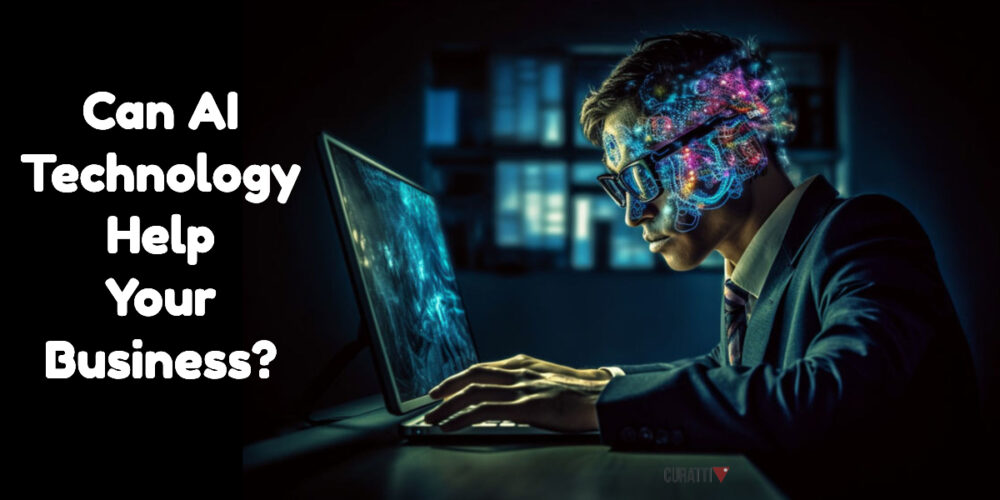Which Components of AI Technology Can Aid Your Business?

…How Do Those Components Differ from Each Other?
Artificial intelligence (AI) is starting to become a major factor in today’s business landscape. Companies are using AI in many different ways, mostly to increase operational efficiency, enhance their marketing efforts, or improve customer service.
However, with all the different tools and types of AI out there, it can be a challenge to pick and choose what will work best for an individual business’s needs. Understanding the different components of AI technology and how they are distinct can help you choose what to invest in.
Embracing AI technology is becoming critical for modern business success. Here’s what you need to know so you can leverage it within your own enterprise.
Defining AI and the Role of Machine Learning
Artificial intelligence is defined as systems that are designed to mimic human intelligence. Computer systems that make decisions, spot patterns, use natural language and problem-solve, all use AI. Artificial intelligence is more efficient than humans, which can cut down on the time and manual processing required for many different tasks.
Although artificial intelligence used to be distinguished from machine learning (ML), today, it is well-accepted that artificial intelligence must, by definition, include machine learning. Machine learning is the concept of machines using data to create better and better results.
AI is designed to mimic human intelligence, and human beings are always learning from the data around them and their own experiences. For a system to be intelligent, it needs to be able to learn from “experience,” or at least the data it’s given.
The Role of Artificial Intelligence in Professional Settings
Artificial intelligence has evolved significantly over the past few years. Previously, only large companies could take advantage of AI tools for analyzing data and creating more efficient workflows.
Today, these tools have become much more accessible. Lots of companies now offer AI tools that provide everything from smart transcription to customer management. In general, businesses can use AI tools to cut down on time-consuming work that machines can often do more efficiently and effectively.
One good example of this is in healthcare. An AI system that manages patient medications can flag potential interactions, verify dosage, and identify duplicate prescriptions, among other things. Not only does this reduce the amount of manual checking that healthcare providers need to do, but it also cuts down on human errors that can lead to real harm.
Chatbots are another great example of how AI can be used in professional settings. Programs like ChatGPT, which is free to all, can help professionals quickly draft documents and emails or even help create websites. Chatbots are also hugely helpful in cutting down on manual customer service tasks.
Key Components of AI Technology
Human intelligence involves a range of skills and abilities, from our use of language to express complex thoughts to our ability to adapt to unfamiliar situations based on prior knowledge. Artificial intelligence involves these components as well, but they are not all equally important in every business setting.
Machine Learning (ML)
Machine learning is a fundamental feature of artificial intelligence. Machine learning uses algorithms and models to make predictions and decisions based on data. It can be “trained” to make better and better decisions over time.
Some applications of machine learning in business include fraud detection and personalization. By being exposed to more and more customer data, the algorithms can start to pick up on attributes in customer profiles and purchases that might indicate fraud or help to provide personalized recommendations based on the individual’s past preferences, demographics, and more.
Although it can be extremely helpful in business contexts, ML is only as good as the data and training it is given, which is something organizational leaders need to be aware of. If an ML program is given access to biased data, for example, the results can be misleading or even harmful.
Natural Language Processing (NLP)
Natural language processing is the component of AI that allows these systems to use and understand human language. It’s why chatbots have become so impressive and believable—so believable that many educators are concerned about how they will distinguish students’ work from that of AI using NLP.
In business, chatbots are extremely helpful in providing basic customer service. Chatbots can allow customers to get help with simple functions and frequently asked questions, leading to quicker, more efficient service while improving engagement and satisfaction. They also help to cut down on the need for service agents to answer the same questions over and over again.
NLP can also be used for many other tasks, including writing product descriptions, finding PR opportunities, enhancing search functions, and providing instant translation services. Depending on the individual enterprise, there can be a wide range of applications.
Computer Vision
Computer vision is the component of AI that allows for the processing of images. Facial recognition programs are the most widely known application of this technology, but they are by far not the only use for computer vision. Another popular use for computer vision is the controversial field of generative art, which uses AI to create artwork based on prompts. Automatic photo editing, medical image analysis, and document analysis are other powerful computer vision tools.
Augmented reality (AR), which involves placing digital objects or images as an overlay in the real-time environment, also relies on computer vision. One example of AR in business is in allowing customers to “place” furniture within their homes using an AR interface so that they can get a better idea of how things will look before they commit to a large purpose.
Predictive Analytics
Data analysis is a critical component of AI, and it’s been helping businesses make better decisions for years. Artificial intelligence technology can drive strategy by using data to make predictions and to understand where opportunities exist for improved operational systems. Predictive analytics can also be used to better understand a business’s target audience for achieving better marketing results.
Choosing the Right AI Components for Your Business
Knowing all the different components of AI will help guide you when choosing the tools and programs you want to use in your business. The first step in that process is assessing business needs.
What industry are you in, and how does that affect your business’s activities? What are your organization’s goals and challenges? What is the budget for AI technologies?
Once you’ve thought about what your needs are, think about where different components of AI might fit in with those needs. If you want to focus on customer service, for instance, natural language processing programs are probably going to be at the top of your list. If your customers need to see a product in their own space, on the other hand, computer vision and AR will be an important investment.
Artificial intelligence is an ongoing and vital investment for modern businesses. It’s important to realize that you’ll need to continue assessing your needs and adjusting based on how effective your AI initiatives prove to be. AI in business is here to stay, and incorporating it into your strategy now is a great way to build a competitive edge.
 Sarah Daren, holding an MBA, is a seasoned consultant and writer in the tech and business sectors. Renowned for her expertise in wearable technology, AI-driven solutions, and innovative strategies, Sarah leverages modern technologies to drive business transformation through her insightful writings and consultations. You can contact Sarah at @sarah_daren
Sarah Daren, holding an MBA, is a seasoned consultant and writer in the tech and business sectors. Renowned for her expertise in wearable technology, AI-driven solutions, and innovative strategies, Sarah leverages modern technologies to drive business transformation through her insightful writings and consultations. You can contact Sarah at @sarah_daren
Sign Up For Our Mailing List
If you’d like to receive more in-depth articles, videos, and Infographics in your inbox, please sign up below.

Sign up for the newest articles from Curatti, delivered straight to your inbox
Featured image: Copyright: ‘https://www.123rf.com/profile_twindesigner‘ / 123RF Stock Photo

CURATTI GUEST

